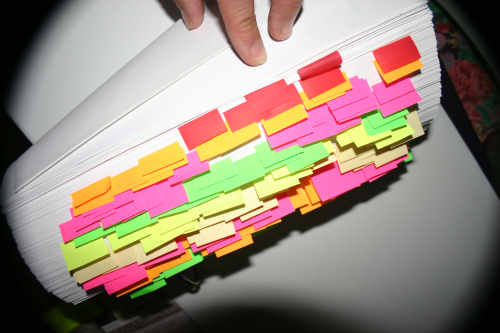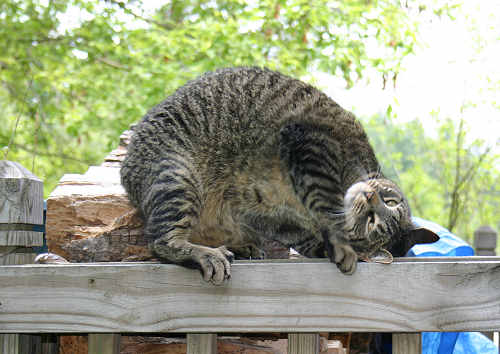A 365-Day Project
"We Are All Mozart"
A project to create
new works and change
the perception of the
music of our time.


 June 14, 2006
June 14, 2006 
Yesterday combined inspiration and exhaustion.
For this project, I distributed in May a productivity survey to about 250 composers who requested it. I expected perfunctory responses from a few folks with extra time on their hands. Instead, 85 composers wrote heartfelt, articulate, passionate and sometimes even cranky responses. I pasted everything into a big file, printed it, and spent the entire day & night with baseball games droning in the background, reading the eloquent pleas sometimes in favor but mostly against the idea of arbitrary productivity, highlighting the most insightful passages, and tagging the pages with Post-its.

By midnight, my head was resting on the notebook, the baseball having given way to shopworn police dramas. Two thousand words. That is the article's limit. In that window, many times the insight would have to be fit.
There is work to be done.
"Feed Me!"
Among the less article-worthy morsels I devoured was that composers and food are fast friends. To the question, "Please add anything else appropriate to the topic," respondents one-lined "add cilantro" and "slivered almonds and a drizzle of chocolate." And in answer to the more serious productivity questions, the need to put food on the table made a frequent appearance. One day an extensive study should be done on the relationship between composers and their food. Peter Shaffer and Milos Forman certainly noticed it enough to mound up the confections in Amadeus., fusing Mozart and Salieri over the exquisite capezzoli di Venere. Concerts without receptions, sometimes bountiful ones, are nigh unknown, and in Europe, concert halls include their own restaurants or pubs. Oh, and pubs, yes, the wine. And composers, sometimes with a great fondness for a dark brew or the odd single malt. Sláinte!
Just so you remember: Feed your local composer.
His Next Aventure
After front-loading my psyche with composers' thoughts, I'm pinballing around some topics today. A subtext yesterday & today is, of course, the death of György Ligeti. Known briefly to the general public for having his music pasted into 2001: A Space Odyssey, Ligeti found his way into my life a few years earlier with his work from the 1960s -- the Aventures set, Lux aeterna and especially Volumina. Composers of our own learning years give us permission to explore what they have explored, but then expect us to brush them away and move on. So it was for me with Ligeti: he gave me permission to create great, vibrating, voluptuous densities. Densities remain part of my genuine vocabulary today, so much so that many of my works can be sliced horizontally like shale, leaving several independent compositions. Köszönöm, György, és istenhozzád.
National Public Rubbish
Very occasionally I'll listen to National Public Radio. It's empty of musical content, but the news is a good underpiddling to washing dishes. Night before last, though, it triggered a serious outburst of slamming plates and splashing water as All Things Considered covered New York's "Iron Artist" competition in the 'Digital Culture' segment. Digital? Not so much. And the idea of creating art to spec in virtually no time was the very premise of Kalvos & Damian's Komposer Kombat in 2005 -- but could we even get a return phone call from ATC for K2? Nope. Rather than merely cute, K2 brought forth forty-one serious creations from three continents, each composed in three hours, and (n.b., audio producers at NPR) we actually used digital culture to do it. The real lesson is that NPR is been consistently and historically hostile to new nonpop, gradually censoring it from their permitted reportage. NPR is a new music bankrupt. Too bad all I had to fling was a plate.
Bark Yer Bruckner
If you ever want to be buried in verbal volcanic ash, pose a "definitional difference" type of question to artists. That's what composer Larry Austin did on the Canadian Electroacoustic Conference list last week. He asked, "I have a simple question for the list: Is 'sound art' music or not?" 170 posts later as of last night, it has unfolded and refolded so many times that the very universe is now in question. From "There's no way of distinguishing between Bruckner's 9th & a dog barking" to "I think these reasons have little if anything to do with the entity itself whose existence cannot be proven," CEC-Conference is a funfest of runaway philosophy and hypersonic deconstruction. In truth, I've learned a lot about how electroacoustic artists have set themselves apart for the past half-century by redefining sound in terms of objects as opposed to form, inventing a world largely outside music and its continuum of listeners, where intention and perception meet in a state of insecure d/r/evolution. It is strange. With music and sound objects simply a wordless state of my hormonic youth, these attempts at description seem more desperate than revelatory. But then, I don't much care about Bruckner or the dog.
Still Listening?
Audiences, yes. So now, back to audiences, a thought I didn't finish last week.
Arguments have long abounded about audiences, from Milton Babbitt's legendary 1958 "Who cares if you listen?" and its proclamation of a fall from musical innocence, through audience-trancing multi-hour minimalists who arrived a slight four years after Uncle's manifesto, to emerging composers two-and-a-half generations later whose creations remain once again calculated as inward-appealing and audience-alien.
Disclaimer: I don't believe in any sort of neo-romantic pandering, but on the other hand, an enormous internal industry has been built on justifying hostility or indifference or detachment or aloofness when it comes to audiences. Don't worry. I'm not about to restate all the historical reasons for that development.
I have been thinking about the expansion of nonpop into this golden age, when communication has widened potential audiences, incorporation of worldwide musical influences is commonplace, and cultural cross-sensibilities are simply anticipated in the arts. Postmodernism is the cheap way of describing it. So in this postmodern time, how do audiences fit into the creative process? Especially if every postmodern audience member must carry around a personal reality, perception set, and message processor?
As a postmodernist-only-when-I-feel-like-it, which isn't now, I suggest that there are ten identifiable audiences: (1) the composer; (2) the colleagues; (3) the performers; (4) the buyers; (5) the critics; (6) the students; (7) the captives; (8) the volunteers; (9) the virtuals; and (10) history. Though they vary in importance to the composer, each possible audience plays a different role in forming the music from the moment the concept undertakes its process of realization. Some audiences can be one and the same, as when a composer performs the music or when colleagues join in performance or improvisation. Some can share roles, as do students (analysts and musicologists among them), captives, and improvising colleagues. Despite where they overlap, though, these ten audiences have distinctly important characteristics, reactions, needs, backgrounds, and listening mechanisms. Indeed, "who cares if you listen?" was never the right question. There are no earlids and, despite the good Uncle's suggestion, no professional audiences. So the question becomes simultaneously more complex and less hostile: "how are you listening?"
Composers may or may not believe they consider the audience when they work. Later for that. For now, who are these people, these elusive audiences? How are they different? What do they want? Expect? Settle for? And what are the implications of the composer's relationship to them, by choice or by chance? What matters about them? I've organized these ten audiences from the geographical inside out:
- Composers are their own primary audience, from the moment an idea arrives. But an idea set down is for outside the composer, for others. The Emily Dickinsonian is a pathological critter. So as audience the composer is in full multi-mode actualization as critic, analyst, experiencer, sometimes performer, and certainly the major investor (despite even late Cage, who invested in the instructions). The composer is the audience most critical, the audience whom nothing will ever satisfy, as nothing will ever match the instructions the composer believes exist but has failed to provide.
- Colleagues include other composers, friends and family (the ones who want to be there, not the captives). Colleagues bring a different kind of investment that may also double as critic. The messages from colleagues are nevertheless always confused, mixed with love and envy, intuition and ignorance. To me, this is the only audience to be set aside in its entirety as unreliable at best and hurtful at worst. There is no expectation that can be met, and no communication that can be clarified.
- Performers are both the acoustic composer's personal audience and the composer's primary translator, ambassador, analyst, mechanic, medium of communication -- and sometimes, just plain medium. Special attention to this audience is ordinarily given in the mechanics (the visual and explicatory quality of a score and parts). But performers' dual role is a precarious one for a composer. Some are heavily committed to a high applause:effort ratio, and will mercilessly maximize it -- sometimes at great cost to the composer's vision.
- Buyers are a special case. These are the commissioners, sponsors, or presenters. They want value for money and safe harbor -- no nonsense, offense, expense, defense. They want your time (just enough, but not too much), and the presentation machine to work well. They want applause. This is also an audience to be dismissed, especially because they are more the audience's audience than yours, a return-on-investment observer with little invested in you.
- Critics are the usual suspects (though to some degree everyone is a critic; I don't mean them). This is an insignificant audience, as their participation is usually post facto. They interact at best with the buyers, and one can take heart that critics are by and large incapable of competent new nonpop criticism -- their critical function has devolved into description of pieces and examination of performances. They validate the performers and the buyers, never the composer. You have been warned. Give them something to describe.
- Students are a strange audience. These include the analyzers, musicologists, and those interested in picking through a smorgasbord of new art. The difficulty comes from this audience's schizophrenic character. Some want to be present even if they do bring a kind of intellectual approach, but some are purely resentful captives (see below). There is little danger from the student audience, but great opportunity for both their growth and the composer's.
- Captives are a wide group, including students fulfilling course requirements, uncomfortable accidents of new-tunes-sandwiched-between-old concert programming, plus partners who attend for social reasons. Captives are especially significant because overcoming their skepticism or barriers or resentfulness or annoyance or apathy and truly enjoining them with your art can engender loyalty of a high order: the loyalty of the convert. (Critics are sometimes captives, and occasionally converts.)
- Volunteers are those who came as fans of nonpop in general or your music in particular. Though it would seem that playing to these audiences is the most rewarding practice, these are your most dangerous audiences, because they want what you last did. Create something new and you risk losing them, with that loss taken by them as betrayal, scorn and even mockery.
- Virtuals are a new class of audience -- the online listeners who can't be predicted. Among them are surfers, those with their virtual radios running, those bored, those hungry for enrichment or entertainment. This special audience can surprise, as with these emails, one of which told me my music "is stunning. Csárdás is one of the top three classical works I have ever heard, doubtlessly," and the other which told me simply, "Your music stink."
- History is also a kind of audience, and for some artists this audience is an important one. Ah, the judgment of history! I think an artist who composes for history is composing for oblivion, but that's just me.
What I've talked about so far is just a surface relationship. On another day, I'll explore how a composer is pulled (wittingly or not) and even tortured by these relationships -- the pitfalls, rewards, panic, and growth that sometimes engender a denial of the audience's role.
Now what have I forgotten? Ah, yes, today's photo! Here is the official obligatory cat Gesualdo, showing his moves on our kitchen porch.

Gesualdo does the macareña to call attention to his lithe handsomeness at age 12.